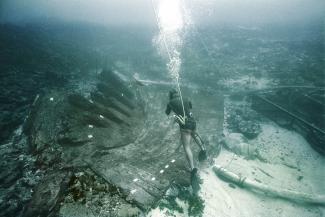In the early hours of 4 June 1629, the Verenigde Oostindische Compagnie (VOC) vessel Batavia, struck and wrecked on a reef of the Houtman Abrolhos islands, 60 km west of Geraldton, Western Australia. The shipwreck was a prelude to an extraordinary tragedy still remembered centuries later.
Batavia’s graveyard
The ship’s passengers and crew made their way to several small coral islands, including Beacon Island which was named Batavia’s Graveyard in the 17th century. In the three and a half months before the arrival of a rescue vessel, the number of survivors was more than halved as a result of a bloody mutiny by members of the crew, including a number of officers.
Archaeology of insurrection
Archaeological evidence includes the shipwreck, structures, sites and artefacts from Morning Reef and several islands in the Wallabi Group of the Houtman Abrolhos islands.
Following its discovery in 1963, the wreck of the Batavia was excavated by the Western Australian Museum including the removal and conservation of the surviving hull. Targeted archaeological investigation of land-based sites has also occurred, particularly after the discovery of human remains. In 2006, the ‘Batavia Shipwreck Site and Survivor Camps Area 1629’ was entered onto Australia’s National Heritage List, sitting alongside the Great Barrier Reef, Uluru, Kata Tjuta National Park and the Sydney Opera House.
An extraordinary collection
The Batavia artefact collection was the first and largest collection of VOC material recovered in an archaeological excavation. It remains one of the finest collections of a 17th century shipwreck on museum display, world-wide. Coins, ceramics, armament, medical supplies, personal possessions, navigation equipment as well as the remaining hull and rigging were recovered and are on display in the WA Shipwrecks Museum in Fremantle, Western Australia.
